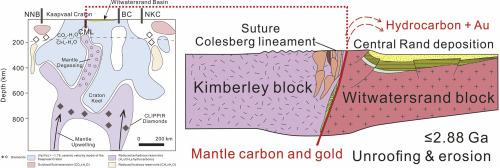The supergiant Witwatersrand Goldfield: A result of anhydrous mantle degassing on Earth’s earliest supercontinent
引用次数: 0
Abstract
The origin of the supergiant high grade Witwatersrand gold deposits has attracted debate for several decades with modified gold placer models contrasting with orogenic gold crustal metamorphic models. Neither explains the anomalous quantities of gold, pyrobitumen, and ‘carbon leaders’ in the Basin during the otherwise gold- and carbon-poor Mesoarchean. The Witwatersrand, part of a trilogy with the Bushveld Complex PGE-Cr-Fe-Ti-V and Kaapvaal diamond fields as the largest deposits globally, is unique, requiring consideration of a tectonic-scale non-conventional model to explain it.
Host to the Witwatersrand Basin, the Kaapvaal Craton represents a continental block within the first supercontinent Ur. Iron-Ni alloy inclusions and terrestrial-like C isotopes in CLIPPIR diamonds within the Craton provide evidence for the addition of metals, including those that later resided in cumulate slurries in the giant Bushveld Complex, to the mantle during Archean core-mantle-crust overturns. Mesoarchean mantle degassing is considered the most likely key process for transport of gold by anhydrous fluids as indicated by CH₄ and H₂ inclusions in CLIPPIR diamonds. The lithosphere-scale Colesberg suture on the western margin of the Witwatersrand Basin, the entry for sedimentary fans during deposition of the Central Rand gold reefs and carbon leaders, represents reactivation of a subduction zone during breakup of Ur at ca. 3.0–2.9 Ga. It is proposed that this suture, recognized as a break in lithosphere profiles, acted as the conduit for CH₄ and H₂ fluids carrying Au in metal hydrides to the mid-upper mantle where CH₄ and H₂ dissociated to form hydrocarbons which extracted additional Au from mantle sulfides. The gold and hydrocarbons were then exhaled on to the western hinterland of the Witwatersrand Basin to provide the anomalous quantity of Au and C required to explain both the Witwatersrand endowment and why such a unique conjunction of factors has never occurred again in Earth history, although most subsequent primary gold-rich deposits are also now considered to have had a mantle connection.

威特沃特斯兰德金矿:地球上最早的超大陆上无水地幔脱气的结果
摘要威特沃特斯兰德超巨型高品位金矿床的成因争论了几十年,修正的金砂矿模型与造山带金地壳变质模型进行了对比。两者都不能解释中太古宙盆地中金、焦沥青和“碳先导物”的异常数量。威特沃特斯兰德(Witwatersrand)与布什维尔德(Bushveld)复杂的PGE-Cr-Fe-Ti-V和Kaapvaal钻石矿是全球最大的矿床,是三部曲的一部分,它是独一无二的,需要考虑构造尺度的非常规模型来解释它。Kaapvaal克拉通是威特沃特斯兰德盆地的所在地,代表了乌尔第一超大陆内的一个大陆块。克拉通内CLIPPIR钻石中的铁镍合金包裹体和类陆相C同位素为太古宙核-幔-壳翻覆期间地幔中添加金属提供了证据,包括后来在巨大的布什维尔德杂岩中沉积的金属。中太古代地幔脱气被认为是无水流体输运金最可能的关键过程,CLIPPIR钻石中的CH₄和H₂包裹体表明了这一点。Witwatersrand盆地西缘岩石圈尺度的Colesberg缝合线是中央兰德金礁和碳先导沉积时期沉积扇的入口,代表了约3.0 ~ 2.9 Ga乌尔断裂期间俯冲带的重新激活。这条断裂带是岩石圈剖面上的断裂,是携带金属氢化物中的金的CH₄和H₂流体进入中上地幔的通道,在那里CH₄和H₂解离形成碳氢化合物,从地幔硫化物中提取额外的金。然后,金和碳氢化合物被呼到威特沃特斯兰德盆地的西部腹地,提供了异常数量的金和碳,这就解释了威特沃特斯兰德的禀性,以及为什么这种独特的因素结合在地球历史上再也没有发生过,尽管大多数后来的原生富金矿现在也被认为与地幔有联系。
本文章由计算机程序翻译,如有差异,请以英文原文为准。
求助全文
约1分钟内获得全文
求助全文

 求助内容:
求助内容: 应助结果提醒方式:
应助结果提醒方式:


